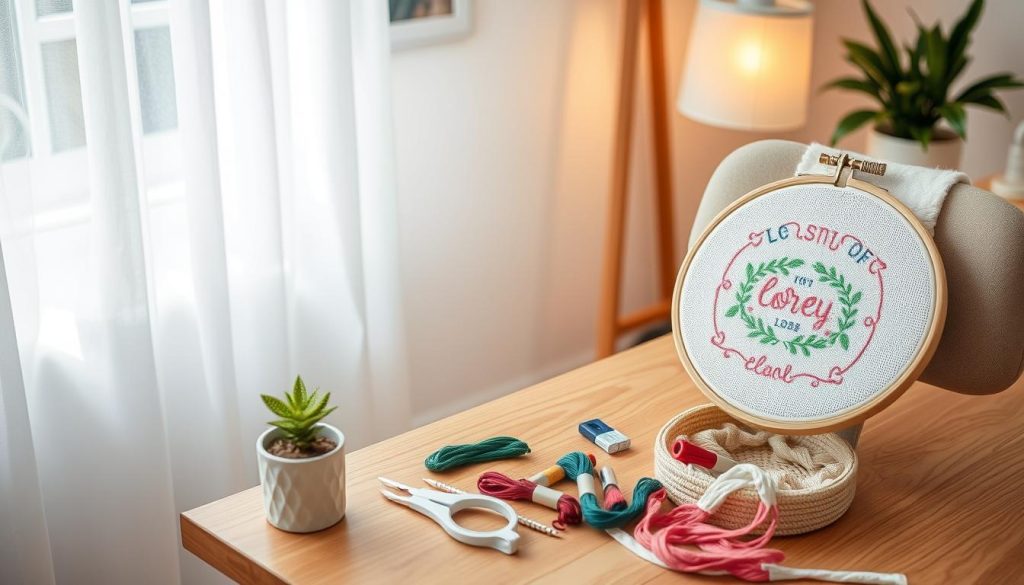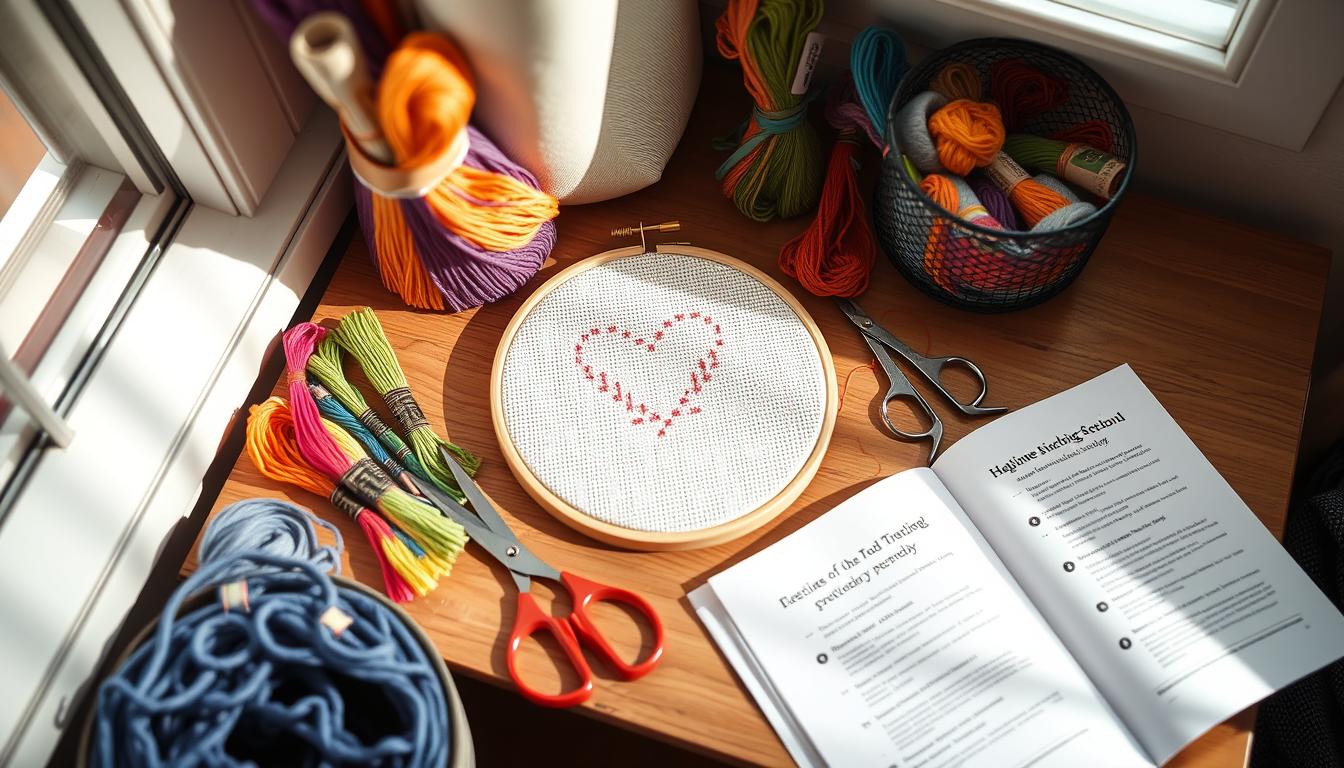Starting with cross stitch can be fun and rewarding. But, beginners often run into common mistakes. These can be avoided with the right tips. Whether you’re looking at new kits, DIY projects, or tutorials, this guide will help you succeed.
Most beginners, over 75%, make errors like picking the wrong fabric or miscounting stitches. Not preparing materials well is another common mistake. By tackling these issues, you can improve your skills and create stunning designs.
Key Takeaways
- Choosing the right fabric count is crucial; approximately 75% of beginners get this wrong.
- Avoid skipping fabric preparation to prevent issues like fraying and wrinkles.
- Miscounting stitches affects design accuracy; nearly 80% of new cross stitchers face this problem.
- Using the specified number of thread strands is key to maintaining texture and consistency.
- Starting in the center of your project can prevent space issues and misalignment.
Using Incorrect Fabric Count
Choosing the right cross stitch fabric is key to getting great results. Many beginners pick the wrong fabric count, which is the threads per square inch. This mistake can mess up the look and size of your work. It’s important to pick the right fabric count.
Understanding Fabric Counts
The fabric count affects the size and detail of your project. Fabrics like Aida cloth come in different counts, like 14-count or 18-count. This means there are 14 or 18 threads per inch. Picking the wrong count can make your design too small or too big.
It’s smart to use a fabric gauge to check the threads per inch. Many cross stitch kits come with the right fabric count. Beginners like Aida fabric because it’s easy to see and count. Learning to pick the right fabric can help you stitch better and avoid mistakes.
Tips for Choosing the Right Fabric
Start with simple fabrics like Aida cloth when you’re new to counted cross stitch. As you get better, try hand-dyed fabrics for a personal touch. But, these need more skill.
- Start Simple: Use 14-count Aida cloth to get used to counting and stitching.
- Measure Accurately: Use a fabric gauge to check the threads per inch, making sure it fits your design.
- Purchase Quality Supplies: Buy good cross stitch supplies, like threads, hoops, and fabrics, for the best results.
- Try Hand-Dyed Fabrics: When you’re more confident, try hand-dyed fabrics for unique projects.
Knowing and picking the right fabric count helps avoid mistakes and makes stitching more fun. Plan well and use the right fabric for your project to get a great finish.
Knotted Threads and How to Prevent Them
Knotted threads can be a big problem in cross stitch projects. But, with the right techniques, you can avoid them. Learning how to handle your cross stitch threads well is key to keeping your work smooth and knot-free.

Optimal Thread Length
The best thread length for cross stitch threads is about 18 inches. This length is just right to avoid tangling or fraying. Having the right thread length can really help prevent knots.
- Use two strands of a single color or mix two colors in the needle for most patterns to cut down on knotting.
- When using multiple strands, separate them to keep your stitching smooth and knot-free.
- While stitching, gently stroke the thread and let it rest to prevent tangling.
Using Thread Conditioners
Thread conditioners like beeswax or Thread Magic can make your cross stitch threads smoother and easier to work with. Even though Thread Heaven is no longer available, Thread Magic is a good alternative that many stitchers like.
- Apply thread conditioner before stitching to keep your threads quality and durable.
- Stitch with two hands to reduce tangling from twisting.
- If you get a knot, gently untangle it to save your project and avoid getting frustrated.
By managing your thread length and using the right cross stitch accessories, you can have a smooth, knot-free stitching experience. Look for different cross stitch tips and techniques to find what works best for you.
| Thread Length | Tips |
|---|---|
| 18 inches | Optimal length to prevent tangling |
| 20 inches | Suitable but may need adjusting if tangling occurs |
| Appx. 10 cm shorter | Recommended if tangling issues persist |
Maintaining Consistent Tension
Keeping the tension even in cross stitch is key for a neat finish. If the tension is off, your stitches might look uneven. Here are some tips to keep your tension just right.
The Importance of Tension in Cross Stitch
Getting the tension right is crucial in cross stitch. It makes sure each stitch looks even on the fabric. If the tension is not even, your design can look messy. So, it’s important to focus on keeping your stitches tight and even.
Using Hoops or Frames
Tools like cross stitch hoops or stands help a lot with keeping tension even. A hoop keeps the fabric tight, making it easier to stitch evenly. Cross stitch stands let you work with both hands, helping you keep the tension even.
Using special techniques like railroading or a laying tool can also help. When you switch between stitches, keep the fabric flat and the stitches even. This keeps your work looking neat and professional.
Uniform Direction in Stitches
Stitching in the same direction makes your cross stitch look better. Most people stitch from bottom left to top right. Sticking to this direction makes your work look neat and professional.
Finishing your cross stitch with techniques like washing it can make your stitches stand out. It makes them look fuller and removes stiffness, leaving you with a beautiful piece.
| Fabric Count | Strands of Floss |
|---|---|
| 14ct or 28ct | 3 strands |
| 16ct or 32ct | 2 strands |
In short, using hoops or stands, sticking to consistent techniques, and finishing your work right will help. You’ll get a professional-looking piece with even tension.
Keeping Your Work Clean While You Stitch
Keeping your cross-stitch projects clean is key for a professional look. A few cross stitch tips and tricks can help keep your work spotless from start to finish.
Begin by washing your hands before you start stitching. This removes oils and dirt that can damage your fabric. Cover your work with a clean cloth when not stitching to prevent dust and spills.
If you get a stain, act fast. A mild soap and lukewarm water can often fix it. Most DMC cotton threads won’t bleed, but test them first to be sure.
When cleaning, use gentle hand wash methods. Stitchers recommend Tide, Downy, Persil, or Perwoll. Use a laundry bag for delicate stitches. Iron with care to avoid melting or shrinking threads.
Food and lotions can also harm your project. Avoid using hand lotions and eating snacks while stitching. This helps prevent stains and keeps your work clean.

Storing your cross-stitch supplies needs to be organized and clean. Use sealed bags or boxes to keep fabric and threads dust-free. These DIY cross stitch tips help protect your work and make stitching cleaner.
For cross stitch finishing techniques, wash your project to remove skin oils. This also gets rid of hoop marks and creases. Don’t wash projects with silk or hand-painted threads to avoid color bleeding. Dry it by gently squeezing out moisture, rolling in a towel, and pressing with a warm iron from the back. Let it air dry flat for the best finish.
Cross Stitch Direction
Keeping a consistent stitch direction is key in cross stitch. It makes your work look better, whether it’s traditional or modern. By always going in the same direction, your stitches will look more uniform and polished.
Consistency in Stitch Direction
Staying consistent with your stitch direction is crucial. Whether you use the American or European method, it makes a big difference. The American Method is popular in U.S. contests, while the European Technique is more flexible.
Choosing one method and sticking to it will improve your work. It shows you’re careful and detail-oriented.
Regularly Checking Your Stitches
Checking your stitches regularly is another important step. This means looking over your work often to make sure everything is even. By doing this, you can fix any mistakes right away.
This is especially helpful in modern cross stitch, where precision is key. Getting into the habit of checking your stitches will make your projects better and more enjoyable.
These basic steps are important for both traditional and modern cross stitch. By following them, you’ll create pieces that are not just beautiful but also show your dedication and skill.
Conclusion
Mastering cross stitch is an art that needs patience and attention to detail. Knowing common mistakes helps a lot. These include using the wrong fabric counts and keeping the tension even.
Always read the instructions carefully. This simple step can help avoid many errors. Also, preparing your fabric well and working in good light are key to great results.
Joining cross stitch communities and following blogs and YouTube channels is helpful. They offer tips and inspiration from others. This can make you feel less alone and more connected.
Cross stitching is more than just a hobby. It can help people recover from brain injuries. It keeps the brain active and can be very rewarding.
Most importantly, enjoy the journey of cross stitching. It’s not just about the end result. It’s about the creativity and relaxation along the way. Cross stitch gifts are especially meaningful because they’re made with love.
